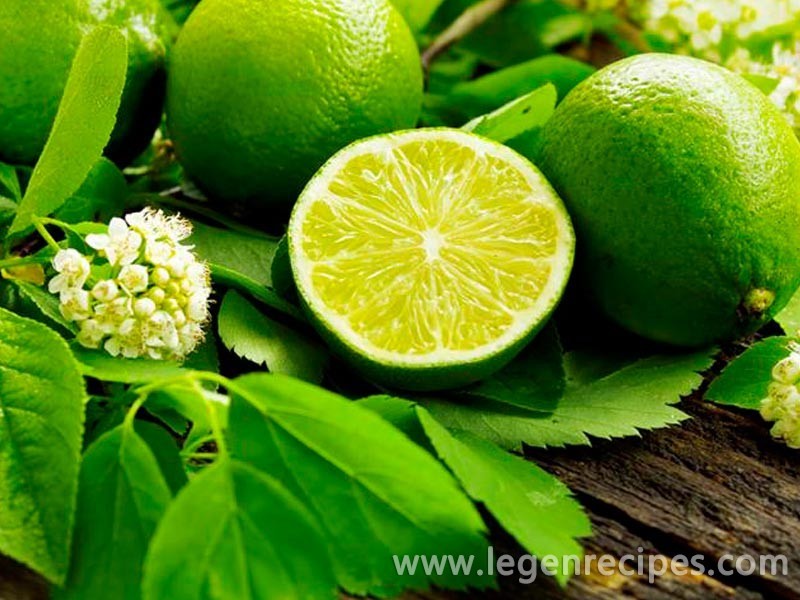Lime (light. Citrus aurantifolia) – citrus fruit of the plant family hails from Asia (with Malacca or India) are genetically similar to lemon. Lime cultivated in India, Sri Lanka, Indonesia, Myanmar, Brazil, Venezuela, in West Africa. On the international market lime it comes mainly from Mexico, Egypt, India, Cuba and the Antilles.
This older and more “wild” brother lemon is one of the champions of the content of vitamin C – even in 1759 at the Royal British Navy its juice (usually mixed with rum) as a remedy for scurvy was introduced into the diet during long sea crossings. Therefore, in the English seaside firmly entrenched slang terms: lime-juicer – the nickname and the English sailor, ship and English, as well as lime-juice – to travel, to wander.
Columbus’s second expedition in 1493 has delivered the seeds of lime to the West Indies, and soon spread lime on its many islands, from where came to Mexico and then to Florida (USA).
The usefulness of lime is not only a large number of vitamin C. Lime contains many other useful substances, which determine its value. The fruit pulp contains citric and malic acid, pectin, salts of copper and potassium, volatile, vitamins F, B and carotene. The nutrition is used as a cleaning agent, it is included in the diet on the excretion of toxins, and the power supply system for weight loss.
In some instances, the lime may cause human acute allergic reaction. This is due, for example, by treatment with lime trees various chemicals to protect them from pests. That’s why limes should be well washed before consumption. Lime is also not recommended for people who suffer from hyperacidity and various diseases of the gastrointestinal tract. If you have colds very sore throat or nose, lime juice will cause severe irritation of the nose, aggravating the situation. Also, lime should not get involved in hypertensive patients and people suffering from pancreatitis.
The types and grades
There are many varieties of lime, which are cultivated in various countries (and different hemispheres). Among them known Mexican (West Indies), Florida, Persian and others.
Along with lime as such (Citrus aurantiifolia) known Palestinian sweet lime (Citrus limettioides) yellow, and very similar to the Iranian limetta lime (Citrus limetta). Their taste is sweeter than that of lime. However, in Russia, these benefits can not be found.
Very sour juice More one citrus fruit – kaffir lime, kaffir lime, the juice of which (as well as the leaves of the plant) in the countries of Indochina are added to soups and main dishes.
There are also hybrids of lime citrus with others – for example, limonaym (lime and lemon), Limequat (lime and kumquat) and others. These plants are often grown in home amateur gardeners.
How to cook
In general, lime in many dishes perfect substitute a lemon, although the taste of the fruit is different. Just as lemon, lime is added to the tea, fish dishes are served. Grated zest of lime gives a special flavor to sauces and desserts.
Lime has become an indispensable ingredient of Caribbean cuisine – local chefs sliced ripe pods of fiery red pepper “habanero” thin strips, flavored with lime juice, salt and served as a seasoning for chicken or beef.
Lime is often used to prepare a variety of cocktails (including mojitos). Somewhere outside of Mexico has developed has become a popular tradition of eating Mexican tequila – with lime and salt (although it should be borne in mind that the majority of Mexicans do not know this tradition and do not understand).
At lime usually smaller bones than lemon.
Lime juice is used to produce citric acid. Oil is used as a flavoring agent in the manufacture of soft drinks.
Season
On the international market lime it comes mainly from Egypt, India and the countries of Central America – from Mexico, Cuba and the Antilles. Also limes are grown in Indonesia, Malaysia, Myanmar, Thailand, Israel, Brazil, Venezuela, in West Africa.
The main crop of lime were collected in August, September and October.
How to choose and store
Choose fruit is elastic, dense and uniformly colored, with a shiny, firm and smooth skin.
If stored properly quality limes – in a cool, dry place – they do not lose their properties for about 3 weeks at room temperature, the fruit can be stored for a week. Purchasing limes for the future do not have to – long lying on their skin is dry, it becomes coarse and covered with spots.
You can save the limes in another way: to squeeze the juice and rub grated zest – the juice poured into conventional molds for ice, and then expanded in plastic bags and store in the freezer up to six months; grated zest can be directly expanded in the same package and freeze.




